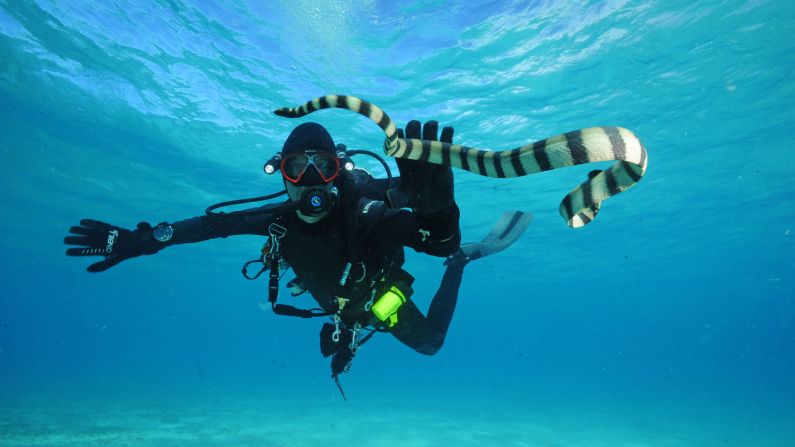
Biomedical scientist Zoltan Takacs has traveled to more than 190 countries in search of venomous creatures that can potentially help create new medical treatments -- like this sea snake in Fiji.
Scroll through the gallery for more on the ways venomous animals are aiding in drug development.
Scroll through the gallery for more on the ways venomous animals are aiding in drug development.

Animal venoms have evolved to immobilize and kill prey in seconds. Venomous toxins target vital body parts with extreme precision and potency, making them valuable templates to craft new drugs. Pictured, a desert viper preys on a gecko.

The venom of the Brazilian lancehead viper was once used on arrowheads. It was later identified as a potent drug to treat high blood pressure and was the first venom-based drug approved by the FDA, in 1981.

Snake venom is captured through a process known as "milking" -- luring snakes to bite onto a material laid over the opening of a jar.

A toxin isolated from saw-scaled viper venom served as the template for the drug tirofiban, used in the treatment of myocardial infarction. The snake is found in the Middle East and the Indian subcontinent.

Viper venom prevents blood from clotting, which can be harnessed for anticoagulant drugs. Pictured, left: Blood from a healthy control coagulates after 20 minutes of test time. Right: Bitten by a mountain pit viper, blood from a patient in Nepal remains unclotted after 20 minutes.

Venomous marine snails such as the cone snail have complex and potent venoms. The drug ziconotide originated from cone snail venom and is today used for the management of severe chronic pain.

The Gila monster is one of the very few species of venomous lizard. It's found in the United States and Mexico and is the source of exenatide -- a drug used to treat Type 2 diabetes.

Toxins produced by sea anemones have been in trials for a drug to treat autoimmune diseases, where the immune system attacks certain cells in the body by mistaking them for invaders.

More than 1,000 species of fish have venom, including the Lionfish found in the Republic of Palau, Micronesia, whose spines have apparatus to produce venom when needed. The vast majority of the world's venomous fish remain unexplored by science.

The venom of the deathstalker scorpion has been in trials for use during surgery to help surgeons locate tumors in the body.

The venom of the fire-bellied toad has been in trials to develop drugs to help image and identify prostate cancer in patients.

Teams at the University of Singapore are working with venom from the King Cobra -- isolating a particular toxin that shows strong potential as a treatment for chronic pain.

Viper venoms are a highly successful source of drugs, but many vipers live in endangered habitats. Pictured, a bush viper hanging from the tree branches at the border of Cameroon and Republic of the Congo.

Teams at the University of Queensland are studying the venom of the the spider tail viper, native to Iran, which has an appendage on its tail resembling a spider to lure its prey. By studying rare and remote animals like these, researchers hope to find toxins that can be used to develop new drugs.

Despite their deadly venoms, sea snakes are commercially harvested in Asia and made into soups. But the venoms of sea snakes and other marine animals remain mostly unexplored and are an important natural treasure.




